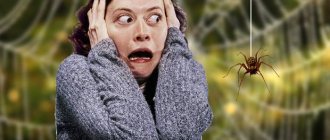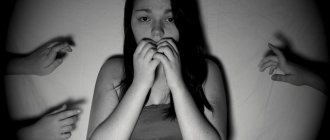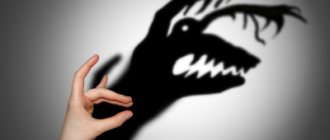Agoraphobia, like other phobias, is considered a type of thinking disorder. That is, with a phobia, a person feels his fear as imposed. In most cases, a critical attitude towards one’s condition remains, but the individual cannot get rid of fears on his own. As a rule, phobias do not indicate that a person has a mental disorder: obsessive fears in psychiatry are classified as disorders of a neurotic level. And such problems can be completely solved through psychotherapeutic work with a psychologist.
Agoraphobia: what is it and how does it manifest?
Agoraphobia comes from two words: agora - bazaar (market, square) and phobos - fear. That is, the term literally translates as “fear of marketplaces.” In a broad sense, agoraphobia is the fear of open space.
A person is afraid of getting lost, being crushed in a crowd, getting into an unpleasant situation, or that he will become ill and no one will help. The root of agoraphobia is distrust of people, lack of self-confidence, and suspiciousness.
This is interesting! People between 20 and 30 years of age suffer most often from agoraphobia. Women are at greater risk, especially those with low social status and those who have problems in relationships with men.
Disease concept
Agoraphobia - what is it? This is a mental disorder based on the fear of open space and places where large numbers of people gather. If a person suffers from a severe form of this deviation, then it often leads to disability, the patient withdrawing into his own world, where he is comfortable. Such people lock themselves at home, communicate with virtually no one, and are unable to work. Agoraphobia - what is it in the severe form? At the peak of the disease, the patient refuses to leave his home, even when left without food, hygiene products or medicine. He is not ready to walk even a few meters to get to the store. Agoraphobia is often accompanied by social phobia, panic disorders, and other mental illnesses.
Symptoms and signs of agoraphobia
Fear of open space rarely occurs in isolation; more often it is associated with other phobias and anxieties, as well as panic attacks. A panic attack can occur anywhere: in a public place, in an open deserted space, among a crowd of people, etc.
How to recognize the disease agoraphobia
Agoraphobia can be recognized by subjective and objective signs. Another feature is waiting. If a person has had a panic attack once, he will constantly wait for the next attack. The tension due to anticipation becomes the cause of a new panic attack.
It is important! Agoraphobes have low self-esteem, fear of loneliness, uncertainty, and fear of losing control. They are sure that if something happens, no one will help them.
Subjective symptoms of agoraphobia
Subjective symptoms are what the person himself feels. The main subjective symptom is fear, but its severity depends on the individual characteristics of the person. Other subjective signs include:
- desire for isolation;
- anxiety in a public place;
- fear of going outside from the house;
- fear of traveling on public transport;
- depersonalization and disorientation.
Objective symptoms of agoraphobia
Objective symptoms are autonomic nonspecific symptoms that are felt by all people with the disorder. Objective symptoms include:
- tachycardia,
- arrhythmia,
- hyperhidrosis,
- shiver,
- dizziness,
- headache,
- ringing and noise in the ears,
- bowel disorder,
- feeling of suffocation
- increased pressure,
- pain and cramps in the abdomen.
Autonomic changes are caused by the production of adrenaline - the fear hormone.
Course of agoraphobia
Fear of open space has a variable course with remissions and complications. In 50% of cases, it is not possible to achieve sustainable remission. At advanced stages of the disease, a person chooses complete isolation; he may not leave the house for months. Such an existence can hardly be called a full life; in such conditions it is impossible to fully realize oneself and open up.
In 50–70% of cases, agoraphobia is accompanied by depression. This condition is dangerous for suicide. In 20–40% new phobias develop. They make a person withdraw into himself even more.
It is important! If depression is added to the phobia, then the patient must be hospitalized urgently.
Panic attacks with agoraphobia
When agoraphobia and panic attacks are combined, a person tends to avoid public places for fear of another attack and for fear of being disgraced and being alone with his problem. A person is afraid of losing control over the situation, of not being able to cope with panic and its consequences. If a panic attack occurs several times in the same place, then when a person gets there, he will have another attack.
Signs of fear in agoraphobia
With agoraphobia, patients experience several related fears:
- fear of cardiac arrest;
- fear of the indifference of others or the absence of people;
- fear of madness;
- fear of suffocation;
- fear of open and closed doors;
- fear of leaving the house.
Panic attacks with agoraphobia
Many people suffering from agoraphobia suffer from panic attacks. The main manifestations of a panic attack are as follows: suddenness and unpredictability, the formation of a reaction that occurs against the background of psychological and physical well-being, as well as severe fear. A situation in which a person is overtaken by a panic attack is perceived as life-threatening. Sometimes, against a background of panic, an obsessive fear of losing your mind appears. The attack may be accompanied by symptoms of a vegetative crisis. Shortly before the attack, a person experiences a feeling of anxiety, as well as pain of unknown origin.
A panic attack is often accompanied by the following symptoms:
- loss of ability to navigate in space;
- panic horror and fear of death;
- dizziness;
- tachycardia;
- unsteady gait and loss of ability to control your movements;
- diarrhea.
Patients perceive the environment as unreal, that is, they experience a state of derealization. Sometimes they have a hysterical attack, accompanied by convulsions and cries for help. The attack can last up to a quarter of an hour, in rare cases it lasts 30 minutes.
After the panic attack subsides, the patient continues to experience severe anxiety for some time. For example, he listens with great attention to his bodily sensations, and perceives the slightest deviations from the norm as manifestations of a dangerous fatal disease.
Panic attacks cause a lot of anxiety for people, having a significant impact on their quality of life.
Causes of agoraphobia
The causes of agoraphobia can be divided into several groups. Let's take a closer look at them.
Genetic factors
In half of the cases, the phobia is inherited. Moreover, the likelihood of genetic inheritance remains even if someone in the family suffered from any anxiety disorder.
Constitutional factors
In this case, we are talking about the psychological constitution of the individual, that is, a combination of temperament, character and other characteristics. Mental characteristics explain why people react differently to the same stress. People who are prone to isolation and have increased anxiety are more susceptible to the negative effects of stress.
Stress and traumatic situations
Agoraphobia develops against a background of prolonged stress. The effect of the stimulus may be weak, but if this effect occurs systematically over a long period of time, the human psyche becomes depleted. An example of chronic stress: conflicts in the family, problems at work. This becomes the basis for the development of anxiety disorders as such.
In some cases, the cause may be an acute one-time shock that has turned into psychological trauma, for example, a real situation in which a person became ill in the square and no one could come to the rescue. In this case, the likelihood of developing agoraphobia is higher.
Having another anxiety disorder
Agoraphobia is often combined with panic disorder and social phobia (fear of public performances). Less commonly, agoraphobia is combined with logophobia (fear of talking), aquaphobia (fear of water), acrophobia (fear of heights) and other phobias.
Accented personality type
Accentuations are overly expressed character traits. Phobias develop against a background of suspiciousness, anxiety, and suspicion. Accentuations are considered a borderline state between normality and pathology; without control and correction they develop into neuroses. People with an avoidant (anxious) personality type have a higher risk of developing agoraphobia than people with other accentuations.
Psychoanalytic concept of agoraphobia
The founder of psychoanalysis, Freud, suggested that any phobia, also known as neurosis, is the result of an intrapersonal conflict. The roots of this conflict go back to childhood or adolescence. Anxiety is the result of a conflict between personal desires and inhibitions. The longer the tension persists, the stronger the severity of the conflict. Later, mental manifestations are joined by physical ones: trembling, a feeling of suffocation, shortness of breath, pain, etc.
Pathological heredity
Initially, it was believed that the main reason for the development of phobias was a hereditary factor. Studies were conducted in which it was possible to find out that the disease occurs more often in identical twins than in fraternal twins. However, later the equal influence of heredity and the influence of the social environment was recognized.
Treatment of mental disorder
If a person admits that he has at least one sign of the disease, then he must constantly resort to preventive measures to prevent the development of agoraphobia. Refusal of alcoholic beverages, a healthy lifestyle, adequate sleep, more frequent communication with people, even if there is no need for this, and all kinds of spiritual practices that help put your thoughts in order and give psychological balance - these are the basics on which the prevention of disorders rests such a plan.
A slightly different algorithm of actions is provided by specialists when making the final diagnosis of Agoraphobia. Treatment of the pathology will largely depend on the root cause of its development, and it is the identification of this cause that the doctor should be concerned with first of all in order to develop an optimal therapeutic regimen.
In total, there are several treatment regimens for agoraphobia :
- Cognitive-behavioral therapy, relevant when the pathology is psychological in nature. In this case, the doctor draws up a detailed clinical picture of the manifestation of the disease and works through each point with the patient, first theoretically, and then consolidating this knowledge with practical experience. That is, we are talking about the gradual immersion of the patient into an environment that is hostile, in his opinion, and his removal from the so-called comfort zones. The more often the patient finds himself in such situations, realizing that nothing fatal is happening and, by and large, no one cares about him, the faster he will recover.
- Drug therapy, which is prescribed for persistent depressive syndrome. In this case, the patient with agoraphobia is prescribed antidepressants and tranquilizers, which must be taken according to a strictly defined scheme with a temporary refusal of cognitive-behavioral therapy (the transition to it will be carried out at the second stage, after it is possible to lift the patient out of depression). In addition, medications can be prescribed to a patient if VSD, as well as other pathologies of the cardiovascular system, are detected.
- Hormonal therapy. It can be prescribed only after a comprehensive examination and in-depth study of the patient’s hormonal background.
- Psychotherapy. Typically, this technique is used when the patient’s agoraphobia is caused by his negative experiences from the past (violence, natural disasters, robbery, etc.). The main task of the specialist in this case comes down to eliminating those negative psychological attitudes that the patient has imposed on himself, so one should be prepared for the fact that it will take a lot of time and effort to achieve a sustainable therapeutic result.
But the best effect, of course, comes from an integrated approach to the problem , when the patient is worked in several directions at once, and in this case, the decisive role can be played by the support of his relatives, who should become a full-fledged support for a loved one in trouble.
1
Diagnosis of agoraphobia
In the International Classification of Diseases (ICD), fear of open space in psychiatry is assigned code F 40.0. The diagnostic criteria for the disease are also indicated there:
- Anxiety. Appears in any situation when a person leaves the house.
- Autonomic manifestations: tachycardia, sweating, trembling, dry mouth, feeling of suffocation, nausea or vomiting, abdominal or chest pain. To make a diagnosis, the simultaneous presence of at least two vegetative symptoms is necessary, and one of them must be from among the first four signs.
- Avoidance of public places and situations related to this. The patient refuses work, rest, and other things in order to avoid a traumatic situation.
- Distress, tension in a situation that causes anxiety and at the very thought of it. The patient realizes that his anxiety and panic are irrational, but still does everything possible to avoid the situation.
Agoraphobia in combination with panic disorder is assigned code F 40.01. This type has its own diagnostic criteria:
- A panic attack, which is manifested by the following symptoms: fear of dying, fear of going crazy during an attack, shortness of breath, pain or other discomfort in the chest, dyspepsia, dizziness and weakness, fluctuations in feelings of hot and cold. To make a diagnosis, at least 4 of these symptoms must be present.
- Feelings of fear and anxiety when being in a public place. Fear at the thought that a person will find himself in a public place from which he cannot get out, or in which no one can help him. Such people experience fear of leaving home, crowds, bridges, public transport or the road itself.
Test for agoraphobia
Additionally, when diagnosing agoraphobia, it is suggested to take the Spielberg-Hanin test for anxiety level. The technique consists of two parts. In the first part you need to answer how you feel at the moment, in the second part - how you usually feel. In each part you need to answer 20 statements. After that, a score is calculated on two scales: personal anxiety and situational anxiety. The result is then interpreted according to the attached key.
It is important! During the diagnostic process, the doctor collects anamnesis, finds out what precedes attacks of fear and how they manifest themselves. In addition, the client’s life history is studied, with special attention paid to finding a protracted conflict.
Spread of agoraphobia among the population
This disorder most often manifests itself in residents of large cities, and is very rarely recorded in people living in rural areas. Most agoraphobes are female. This is explained by socio-cultural foundations that allow a woman to be defenseless and weak. In addition, ladies more often seek medical help, when the majority of representatives of the stronger half of humanity prefer to muffle the manifestations of agoraphobia with alcoholic drinks.
The onset of the disease most often occurs in adolescence and early adulthood. Obsessive intense fear can manifest itself in some emotionally labile, schizoid, asthenic psychopathy, epilepsy, manic-depressive psychosis. Agoraphobia affects somatically and mentally weakened, asthenic individuals. The disease affects people with somatogenic neurosis-like conditions (for example: patients with chronic bronchitis, lung diseases, gastroduodenitis). Agoraphobia often accompanies organic diseases of the central nervous system (infectious origin, vascular origin, various tumors, after traumatic brain injury).
An interesting fact has been established by scientists that in people suffering from agoraphobia, the activity of the vestibular apparatus is almost always poorly developed. Patients mainly focus on tactile and visual perception of the surrounding world. In the case when vision “fails”, producing blurry, indistinct images, the person is instantly disoriented in space.
According to DSM-IIIR, conditions with symptoms of agoraphobia and panic attacks are classified in the subgroup of panic disorders.
Methods of psychotherapy used in the treatment of agoraphobia
Several psychotherapy methods are used to treat agoraphobia. Let's look at each of them in more detail.
Behavioral psychotherapy
In the process of individual or group training, the client learns new behavior patterns. He is taught relaxation techniques, helped to relax, and then brought face to face with fear. The client first makes a list of frightening situations in order of increasing fear. Getting closer to fear occurs according to this list.
Cognitive psychotherapy in the treatment of agoraphobia
Cognitive psychotherapy involves working on the perception and thinking of an individual. Fear is caused by an inadequate perception of oneself and the situation, erroneous judgments. In 15–20 sessions, a psychologist will be able to correct this. During therapy, the client must understand that fear is caused by the costs of education, individual personality characteristics and developmental specifics, and not by real threats. This awareness helps overcome fear.
Gestalt therapy
Gestalts are human needs. An incomplete gestalt is a violation of the pattern “desire - search for ways to satisfy it - satisfaction - way out of the situation.” To get rid of agoraphobia, you need to find all unfinished gestalts and close them, that is, satisfy all suppressed desires.
Hypnotherapy
Hypnosis is one of the radical methods. The client is immersed in a trance, the specialist inspires the irrationality of his fears, and the patient is taken out of the trance state. The attitude of absence of danger is recorded on a subconscious level.
It is important! Hypnosis is not suitable for people with hysteria, delusions and low susceptibility to suggestion.
Psychodynamic psychotherapy
This method looks for the cause in old conflicts between a person and the outside world. A psychologist helps to discern the problem at the subconscious level and bring it to the conscious level. For this, the method of free association is used - a person says the first thing that comes to mind. There are no restrictions or boundaries. Spoken words and phrases help to find the hidden motives of fear.
Paradoxical intention
The psychologist creates within the individual a desire to do something that scares him. To do this, the specialist uses the method of ironic ridicule.
How to get rid of agoraphobia using paradoxical therapy:
- talk about the symptoms of the disease as vital elements;
- prohibit the client from doing what he is already afraid to do;
- exaggerate the attitude towards symptoms;
- ask the client to teach the psychologist to be afraid (teach agoraphobia).
Sometimes the methods are used in combination.
Eye movement desensitization and reprocessing (EMDR)
According to this theory, every person has a psychophysiological mechanism, the activation of which promotes forgetting and neutralization of negative information. Stress blocks this part of the brain. To unlock the mechanism, you need to make certain movements with your eyes. The exercises are carried out strictly under the supervision of a psychotherapist.
Frequently asked questions about this
What is the name of obsessive fear, fear of open spaces?
If a person has a number of physiological and psychological symptoms associated with the fear of going out, appearing in public places alone, refusal to contact people outside the home, panic begins in playgrounds, in large rooms, shopping centers, then there is reason to suspect such a pathology neurotic spectrum, such as agoraphobia. If you don’t start getting rid of it in time, then a person can become a recluse, stop communicating with friends and acquaintances, and not leave home, even when there is an urgent need to do so.
I have agoraphobia, what self-help methods can help me get rid of it?
Psychotherapeutic treatment helps patients who are aware of the problem. It is also important to independently set yourself up for recovery, assess what fears bother you, and at what moments a person feels good. Various exercises for visualization, presentation, modeling, and role-playing games help. It is necessary to concentrate on the good and positive in order to get rid of unnecessary anxiety, try to refuse the constant accompaniment of loved ones if you go somewhere in a public place. Try to go outside more often, even if it is very uncomfortable at first.
How to deal with agoraphobia yourself
It is necessary to get rid of erroneous attitudes and learn psychophysiological self-regulation. The following methods are suitable for independent work.
Understanding the mechanism of agoraphobia
The fear of being alone indicates a lack of trust in people. It is necessary, with the help of auto-training, to form the attitude “I am good, people are good, the world is good” and deal with the root causes of mistrust. Most likely, the problem lies in relationships with parents or other people. We need to remember when a hostile attitude towards the world was formed.
In addition, it is necessary to analyze specific attacks. If panic overtakes you in a specific place, then this is due to the formation of a conditioned reflex: once a panic happened in this place, you remember it, returning here, you remember it and expect a new attack, because of the tension it happens. Your fixation on the problem and attempts to avoid a traumatic situation are to blame.
Stop avoiding space
How to get rid of agoraphobia on your own: break the chain of “place - bad experience - danger - avoidance.” You need to come to that place and replace the bad experience with a good one. Plan what it will be and repeat the new pattern many times.
Don't discuss your problem
Discussing the problem does not produce results. There is no need to think about how bad it is and feel sorry for yourself. You need to make an action plan and start taking action.
It is important! People with anxiety disorders tend to internalize the fears of other fearful people. When communicating with someone who has the same diagnosis, you may begin to fear places that you were not afraid of before.
Relaxation and relaxation
How to fight with relaxation, what methods to use:
- progressive relaxation (alternate tension and relaxation of individual muscle groups);
- breathing exercises;
- visualization;
- alternate concentration and relaxation.
Test - are you a phobe?
If you are looking for information about agoraphobia, this is the fear of what, how to get rid of it, try taking the test on our website. Videos and photographs of real cases will also help you learn more about the deviation.
Write your answers in the comments!
Interesting Facts
What is agoraphobia in psychiatry? The term first became known in 1871, when a designation was needed for patients suffering from a fear of appearing in public places. Until this time, deviation was considered as a form of generalized anxiety.
The fear of space was inherent in many famous personalities: Marilyn Monroe, Makalay Culkin, Kim Basinger, Woody Allen.
Prevention of agoraphobia
For prevention, you need to increase stress resistance: lead a healthy lifestyle, exercise, watch your diet, relax, monitor your work and rest schedule. We must strive to reduce the influence of factors that provoke the development of a phobia.
Provoking factors for agoraphobia
Negative factors include:
- childhood trauma;
- chronic stress;
- psycho-emotional instability;
- psychosomatic diseases;
- difficult life situations (job loss, divorce, accident, bankruptcy);
- alcoholism;
- hormonal changes in the body, including pregnancy and menopause in women;
- long-term use of psychoactive drugs;
- character traits.
Unfavorable character traits: suspiciousness, excessive self-criticism, hyper-responsibility, demanding of oneself, a tendency to self-examination and self-punishment, developed imagination.
How to avoid recurring attacks of agoraphobia
After achieving remission, you need to follow the doctor’s recommendations, attend maintenance courses of psychotherapy, and take pills if necessary. It is important to continue to independently work on fear, change attitudes, and master self-regulation techniques.
Manifestation of phobia
The main manifestation of agoraphobia is an obsessive fear of an upcoming trip to a crowded place, or immediately while outside the home, up to panic attacks. As a rule, the patient remains critical of his condition, but at the moment of panic there are short periods of time when the person completely loses control. The presence of criticism confirms the neurotic nature of the disorder. However, the main somatic symptoms are present:
- dizziness;
- loss of orientation in space;
- fainting;
- cardiopalmus;
- hyperventilation, suffocation;
- nausea;
- tremor of the limbs;
- heavy sweating;
- stuffy ears, ringing;
- derealization.
In order not to experience such a set of unbearable symptoms, agoraphobe avoids as much as possible situations in which there is a need to leave the comfort zone. Voluntary imprisonment of oneself in a cage leads to even greater dependence, social phobia and neuroses.
Clinical psychologist Veronika Stepanova talks about the symptoms of agoraphobia, the origins and reasons for its appearance in humans in a video
Recommendations
- If you have a drug, alcohol or nicotine addiction, be sure to try to deal with it. If at first, thanks to, say, marijuana, it will be easier for you to achieve calm, then believe me, the moment will come when you will literally “fall” into a state of anxiety that will not leave you for a minute. And no amount of drugs will be able to cope with it.
- Go in for sports, at least yoga, meditation. This way you will get rid of unnecessary tension and, in general, emotions that have accumulated. And also switch your attention from the object of fear to your own body and sensations.
- Lead a healthy lifestyle. High-quality nutrition, good sleep, exercise in the morning - all this is the key to not only physical, but also mental health.
- And be sure to follow the recommendations of specialists and the treatment plan.











